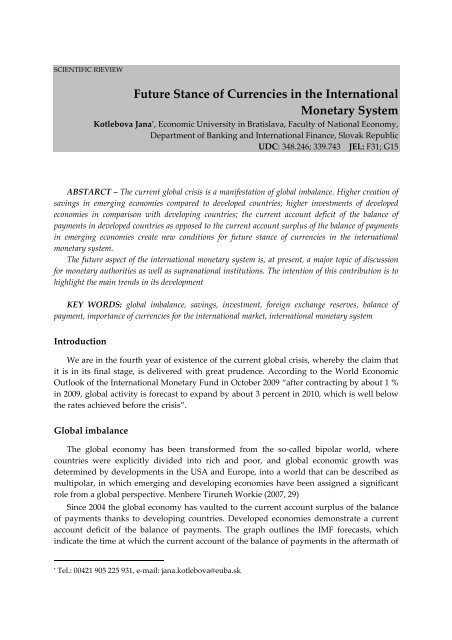Twice a Year Scientific Journal
Twice a Year Scientific Journal
Twice a Year Scientific Journal
You also want an ePaper? Increase the reach of your titles
YUMPU automatically turns print PDFs into web optimized ePapers that Google loves.
SCIENTIFIC RIEVIEW<br />
Future Stance of Currencies in the International<br />
Monetary System<br />
Kotlebova Jana * , Economic University in Bratislava, Faculty of National Economy,<br />
Department of Banking and International Finance, Slovak Republic<br />
UDC: 348.246; 339.743 JEL: F31; G15<br />
ABSTARCT – The current global crisis is a manifestation of global imbalance. Higher creation of<br />
savings in emerging economies compared to developed countries; higher investments of developed<br />
economies in comparison with developing countries; the current account deficit of the balance of<br />
payments in developed countries as opposed to the current account surplus of the balance of payments<br />
in emerging economies create new conditions for future stance of currencies in the international<br />
monetary system.<br />
The future aspect of the international monetary system is, at present, a major topic of discussion<br />
for monetary authorities as well as supranational institutions. The intention of this contribution is to<br />
highlight the main trends in its development<br />
KEY WORDS: global imbalance, savings, investment, foreign exchange reserves, balance of<br />
payment, importance of currencies for the international market, international monetary system<br />
Introduction<br />
We are in the fourth year of existence of the current global crisis, whereby the claim that<br />
it is in its final stage, is delivered with great prudence. According to the World Economic<br />
Outlook of the International Monetary Fund in October 2009 “after contracting by about 1 %<br />
in 2009, global activity is forecast to expand by about 3 percent in 2010, which is well below<br />
the rates achieved before the crisis”.<br />
Global imbalance<br />
The global economy has been transformed from the so-called bipolar world, where<br />
countries were explicitly divided into rich and poor, and global economic growth was<br />
determined by developments in the USA and Europe, into a world that can be described as<br />
multipolar, in which emerging and developing economies have been assigned a significant<br />
role from a global perspective. Menbere Tiruneh Workie (2007, 29)<br />
Since 2004 the global economy has vaulted to the current account surplus of the balance<br />
of payments thanks to developing countries. Developed economies demonstrate a current<br />
account deficit of the balance of payments. The graph outlines the IMF forecasts, which<br />
indicate the time at which the current account of the balance of payments in the aftermath of<br />
*<br />
Tel.: 00421 905 225 931, e-mail: jana.kotlebova@euba.sk
















